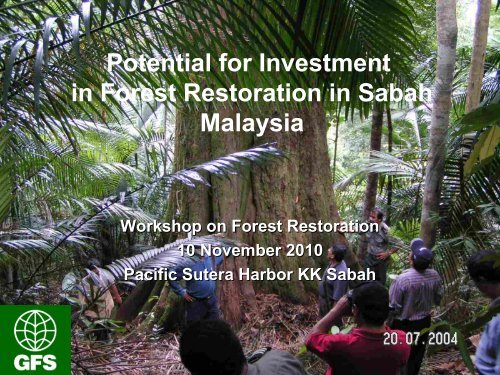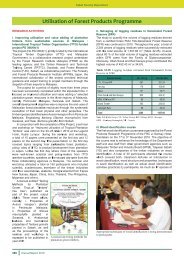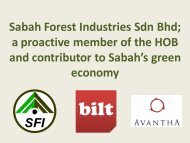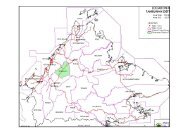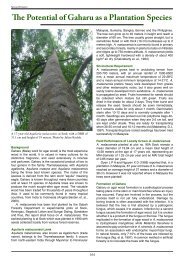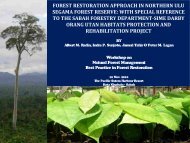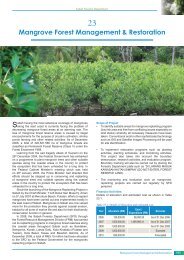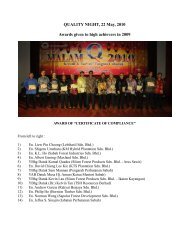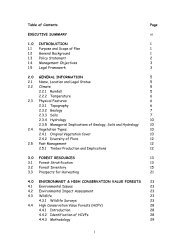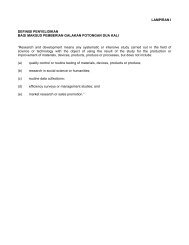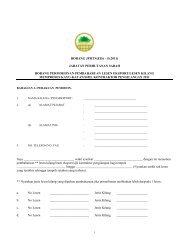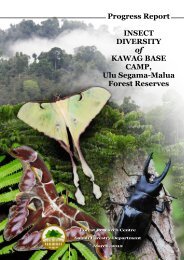Reforestation FMU 17A - Sabah Forestry Department
Reforestation FMU 17A - Sabah Forestry Department
Reforestation FMU 17A - Sabah Forestry Department
You also want an ePaper? Increase the reach of your titles
YUMPU automatically turns print PDFs into web optimized ePapers that Google loves.
Potential for Investment<br />
in Forest Restoration in <strong>Sabah</strong><br />
Malaysia<br />
Workshop on Forest Restoration<br />
10 November 2010<br />
Pacific Sutera Harbor KK <strong>Sabah</strong>
Global <strong>Forestry</strong> Services<br />
Background<br />
Rainforests are depleting<br />
worldwide through over logging<br />
and land conversion to<br />
agriculture that has resulted in<br />
loss of habitat and contributes<br />
to nearly 20% of global carbon<br />
emissions that is effecting<br />
climate change.
Global <strong>Forestry</strong> Services<br />
Background<br />
Deforestation alone is stated<br />
to cause more emissions<br />
than ALL the emissions from<br />
transport (cars, busses,<br />
ships, airplanes, etc)<br />
worldwide that is estimated<br />
to be about 13%.<br />
Most deforestation is<br />
happening in tropical<br />
rainforests, which is home to<br />
the most biologically diverse<br />
habitat and animal species<br />
on the planet
Global <strong>Forestry</strong> Services<br />
<strong>Sabah</strong><br />
The Forests of <strong>Sabah</strong> have<br />
been logged heavily over<br />
the past 30 years that has<br />
now resulted in most forest<br />
reserves being degraded to<br />
non-productive status.<br />
The <strong>Forestry</strong> <strong>Department</strong><br />
has traditionally provided the<br />
<strong>Sabah</strong> State Government<br />
with the majority of revenue<br />
needed to fund the<br />
government budgets.
Global <strong>Forestry</strong> Services<br />
<strong>Sabah</strong><br />
It is a critical time for <strong>Sabah</strong><br />
to evaluate the potential to<br />
earn revenue through forest<br />
rehabilitation in the wake of<br />
Global Warming and the<br />
development of markets for<br />
Carbon Offsets coupled with<br />
long term Green Investments<br />
that can directed into forest<br />
rehabilitation.
Global <strong>Forestry</strong> Services<br />
<strong>Forestry</strong> Investments<br />
In general populations are increasing that directly relate to an<br />
increasing demand for wood and paper products from a dwindling<br />
resources from natural forests<br />
Source: FAO | Forecast Widman Research
Global <strong>Forestry</strong> Services<br />
<strong>Forestry</strong> Investments<br />
There is a general push<br />
towards Green Investments<br />
that focuses on plantation and<br />
forest areas.<br />
There are numerous<br />
schemes to make money by<br />
growing trees
Global <strong>Forestry</strong> Services<br />
<strong>Forestry</strong> Investments
Global <strong>Forestry</strong> Services<br />
<strong>Forestry</strong> Investments<br />
Wood Land / Timber Land<br />
management in USA<br />
Biological growth (~57%*)<br />
• Independent of all other factors<br />
• Largest component<br />
• Highly predictable<br />
Timber prices (~25%*)<br />
•Consistently trended above inflation<br />
over the last century<br />
Timberland prices (~17%*)<br />
• Annual rate of change about 11%
Global <strong>Forestry</strong> Services<br />
<strong>Forestry</strong> Investments<br />
Radiata pine plantations in New<br />
Zealand rated at rate of return of<br />
more than 16.24% 4 compounded<br />
per annum for the 30 plus years<br />
of the investment
Global <strong>Forestry</strong> Services<br />
<strong>Forestry</strong> Investments<br />
Eucalyptus and mixed<br />
species plantations in<br />
Australia<br />
However the project does not<br />
provide an estimated rate of<br />
return but just estimates<br />
growth rates over the harvest<br />
period and projected sales<br />
prices
Global <strong>Forestry</strong> Services<br />
<strong>Forestry</strong> Investments<br />
Teak tree plantations in Sri<br />
Lanka<br />
The project estimates IRR of<br />
21.3% based on thinning year<br />
9 and final harvest year 15 with<br />
extremely high sales values of<br />
GBP 1,174/tree at final harvest.
Global <strong>Forestry</strong> Services<br />
<strong>Sabah</strong>, Malaysia<br />
<strong>Sabah</strong> is a state in East Malaysia and is situated in the northern part of<br />
Borneo that contains approximately 3.7 million ha of forest mostly of logged<br />
over natural forests
Global <strong>Forestry</strong> Services<br />
<strong>Reforestation</strong> <strong>FMU</strong> <strong>17A</strong><br />
The key objective of this<br />
project is to establish a<br />
sound Environmentally<br />
friendly - Green<br />
investment project<br />
centered on restoring<br />
productivity of tropical<br />
rainforests and provide a<br />
significant return on<br />
investment to the investor.
Global <strong>Forestry</strong> Services<br />
Project Objectives<br />
Support the <strong>Sabah</strong> <strong>Forestry</strong><br />
<strong>Department</strong> to restore degraded<br />
forest areas through external<br />
funding to make the area<br />
economically viable within the<br />
management planning period.
Global <strong>Forestry</strong> Services<br />
Project Objectives<br />
Planting trees and restoring<br />
degraded forests will in turn<br />
support global efforts to<br />
prevent climate change by<br />
increasing carbon<br />
sequestration in planted<br />
trees.
Global <strong>Forestry</strong> Services<br />
<strong>Sabah</strong>, Malaysia<br />
Tree plantations of both native<br />
and exotic species are being<br />
established to supplement logs<br />
production from natural forests.<br />
Malaysia is an open market<br />
economy which offers a stable<br />
investment climate for investors.
Global <strong>Forestry</strong> Services<br />
Forest Management Unit <strong>17A</strong><br />
<strong>FMU</strong> <strong>17A</strong> (50,020 ha) consists of Tangkulap & Sg. Pinangah<br />
Forest Reserves that is heavily degraded due to excessive<br />
logging over the past 15 years.
Global <strong>Forestry</strong> Services<br />
Forest Management Unit <strong>17A</strong><br />
The project site within <strong>FMU</strong> <strong>17A</strong> would be<br />
chosen based identification of severely<br />
severely degraded compartments without<br />
the ability to self regenerate.<br />
Restoration could be conducted using a<br />
mosaic design to conserve existing valuable<br />
trees, while planting of dipterocarps and fast<br />
growing local species on the degraded areas<br />
within each compartment
Global <strong>Forestry</strong> Services<br />
Forest Management Unit <strong>17A</strong><br />
A compartment level inventory was conducted and identified<br />
over 80% of the area was classified as very poor forest<br />
(Strata 4).<br />
Stratum<br />
Forest<br />
Description<br />
Number of trees<br />
ha -1 ≥ 60 cm dbh<br />
Area<br />
(ha)<br />
% of<br />
total<br />
area<br />
1 Good forest > 16 143 0.2<br />
2 Moderate forest 9-16 520 1.0<br />
3 Poor forest 5-8 4,563 9.0<br />
4 Very poor forest 0-4 40,536 81.4<br />
5 Small crown<br />
forest*<br />
NA 4,141 8.4
Global <strong>Forestry</strong> Services<br />
Project Site<br />
The project site within <strong>FMU</strong> <strong>17A</strong> has been<br />
chosen based on 38 compartments within the<br />
very poor strata that are considered severely<br />
degraded<br />
Strata 4 that has less than 50 potential crop<br />
trees/ha that does not have the ability to self<br />
regenerate naturally within a reasonable time<br />
frame.
Global <strong>Forestry</strong> Services<br />
Project Site Map
Global <strong>Forestry</strong> Services<br />
Restoration Methods<br />
• Mosaic system can be used<br />
to plant fast growing native<br />
trees within severely<br />
degraded sections of each<br />
of the compartments to a<br />
maximum size of 30 ha<br />
• Tree species to be planted<br />
are Binuang, Laran,<br />
Sentang, etc. which are<br />
suitable for chip wood<br />
plywood, laminated boards,<br />
veneer, etc.
Global <strong>Forestry</strong> Services<br />
Restoration Methods<br />
Prior to planting compartment restoration plans<br />
need to be developed that define highly<br />
degraded patches for planting and better forest<br />
areas for conservation within each<br />
compartment
Global <strong>Forestry</strong> Services<br />
Restoration Methods<br />
• A maximum of 60% of any compartment<br />
within the project can be planted<br />
• A minimum of 40% of the project area will<br />
remain in natural forest to conserve existing<br />
valuable dipterocarps and biodiversity across<br />
the landscape.
Global <strong>Forestry</strong> Services<br />
Restoration Methods<br />
• The Investors will earn revenue from the fast<br />
growing planted trees & carbon credits.<br />
• Restoration will also include planting of 15-25% of<br />
the area in both fast growing & high value<br />
dipterocarps to enhance biodiversity.<br />
• The fast growing species can provide the shade<br />
needed to grow the slower growing dipterocarps
Global <strong>Forestry</strong> Services<br />
Basic Assumptions<br />
• Net planting area 11,500 ha out of 23,000 ha within<br />
38 compartments<br />
• Planting density 3*5m 667 seedling/ha<br />
• Harvest volume chip wood 168m3/ha @ 7 years<br />
• Harvest volume utility timber 235m3/ha @ 15 years<br />
• Harvest costs RM 45/m3<br />
• SFD Land Rent USD 500/ha over project period<br />
• SFD management fees
Global <strong>Forestry</strong> Services<br />
Investment Overview<br />
• Revenue for investors are from logs sales of<br />
planted fast growing trees and associated<br />
carbon credits<br />
• Initial land preparation costs may be partly<br />
defrayed by logs sales from land clearing<br />
• Maintenance costs partly defrayed by proceeds<br />
from commercial thinning of planted trees<br />
• Planted trees are fast growing native species<br />
and ready for harvesting by 7 years for chip<br />
wood or 15 years for utility timber.
Global <strong>Forestry</strong> Services<br />
Chip wood 7 year cycle<br />
Annualized IRR of 20%<br />
Return on Investment of 14%<br />
Project duration is 20 years<br />
Investment required US<br />
$2,500 /ha US$ 28.5mil<br />
Net total returns US$102 mil<br />
Expected Returns<br />
Utility Timber 15 year cycle<br />
Annualized IRR of 15% to 17%<br />
Return on Investment of 18% to 23%<br />
(After Tax 12% to 16%)<br />
Project duration is 20 years<br />
Investment required US $3000/ha<br />
or US$ 34.5 mil<br />
Net total returns US$195 mil
Global <strong>Forestry</strong> Services<br />
<strong>Sabah</strong> <strong>Forestry</strong> <strong>Department</strong><br />
• SFD is the resource holder<br />
and manager of the<br />
reforestation project<br />
• SFD has excellent track<br />
record from managing FSC<br />
certified Deramakot Forest<br />
Reserve<br />
• Through this project SFD<br />
can earn management fees,<br />
land lease and timber<br />
royalties from the project
Global <strong>Forestry</strong> Services<br />
<strong>Sabah</strong> <strong>Forestry</strong> <strong>Department</strong><br />
Key Benefits<br />
• No cash outlay required from SFD<br />
• Leverage on existing management team to earn<br />
management fees<br />
• Fully paid technical support and monitoring from<br />
GFS<br />
• Receive paid land lease US$ 5.7 mil<br />
• Receive management fees US$ 6.4 mil<br />
• Receive logs sale royalty US$ 21.9 mil for utility<br />
timber or US$ 6.9 million<br />
• Total estimated project revenue US$ 34.1 mil<br />
under utility timber and 20.5 mil under chips
Global <strong>Forestry</strong> Services<br />
Global <strong>Forestry</strong> Services<br />
GFS will provide the technical<br />
support to design the project &<br />
monitor development /<br />
implementation and provide<br />
progress reports to the SFD &<br />
Investment Organization<br />
FSC & VCS standards will be<br />
adopted to ensure credibility in<br />
forest management & ensure<br />
carbon credit objectives are<br />
met
Global <strong>Forestry</strong> Services<br />
Conclusions<br />
• Forest restoration is economically viable based on<br />
calculations of IRR and annual rates on returns that<br />
is comparable to current market rates<br />
• Investment can be used to generate income to SFD<br />
that would not be available under degraded natural<br />
forest conditions.<br />
• The use of the mosaic design to mitigate negative<br />
impacts can be used to meet certification<br />
requirements.
Global <strong>Forestry</strong> Services<br />
Thank you<br />
www.gfsinc.biz
Global <strong>Forestry</strong> Services<br />
Investors Q & A<br />
• What returns do forestry investments yield<br />
Historically, returns in mixed woodland in North America<br />
have averaged 14.5% per annum over the last 30<br />
years.<br />
• What about fire, drought, pests and disease risks<br />
With any investment there is always the element of risk.<br />
Historically, managed plantations lose 0.3% to natural<br />
influences. To mitigate these risks, fire breaks are built<br />
and proven management practices are applied to ward<br />
off pests and diseases.<br />
• On what basis is the project’s financial model built<br />
The financial model is developed using conservative<br />
assumptions based on current costs and prices. The<br />
price of timber and timber products has increased<br />
consistently in the past decade due to increasing<br />
demand from fast developing Asian economies.
Global <strong>Forestry</strong> Services<br />
Investors Q & A<br />
• What returns do I get The project’s carbon credit sale and<br />
logs sale revenue (less operating expenses, timber royalty and<br />
5% fee) forms the main returns to the investor. Other revenue<br />
from commercial thinning of trees and land clearing will be<br />
used to offset operating expenses.<br />
• Who will manage the funds that is invested A trustee<br />
organization will be appointed to hold and disburse the funds<br />
to the project on a progress basis. Any excess funds will be<br />
invested in time deposits with reputable banks. The trustee will<br />
also prepare audited annual accounts on the funds under<br />
management.<br />
• How am I informed on the progress of the project The<br />
project designer, GFS will also monitor the project and prepare<br />
independent regular progress reports to the investor, trustee,<br />
and SFD.


